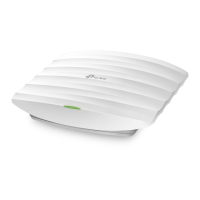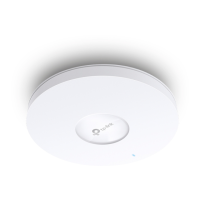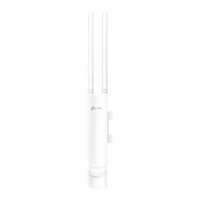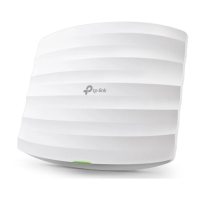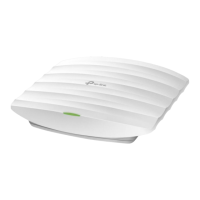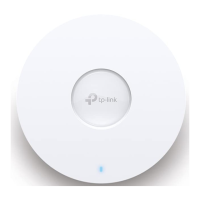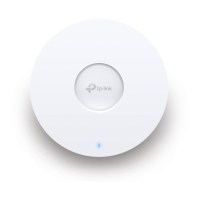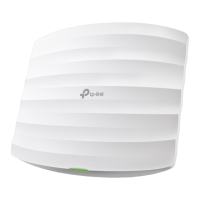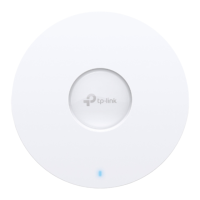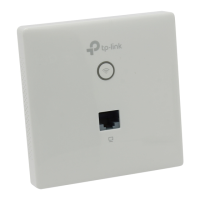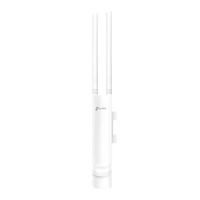Do you have a question about the TP-Link Omada EAP773 and is the answer not in the manual?
Guide to selecting between Controller Mode and Standalone Mode for EAP management.
Steps for physically connecting EAPs to the network and clients to the EAP.
Instructions for accessing the EAP interface and changing the wireless network name.
Overview of EAP configuration and management options via the web interface.
Setting up SSIDs, security, channel, and advanced wireless radio configurations.
Implementing guest authentication using captive portal or local password.
Assigning VLAN IDs to wireless SSIDs for network segmentation.
Controlling network access by allowing or blocking specific device MAC addresses.
Scheduling EAP radio on/off times to manage power and availability.
Steering dual-band clients to optimize band usage and network performance.
Optimizing network performance by prioritizing traffic types and applications.
Detecting and managing unauthorized access points to secure the network.
Enhancing Wi-Fi performance with intelligent antenna array technology.
Reviewing EAP device status, hardware, firmware, and operational uptime.
Checking SSID configurations, radio settings, and wireless traffic statistics.
Viewing information about connected wireless clients and their activity.
Centrally managing EAPs configured as wireless bridge components.
Configuring the EAP's IP address mode (Dynamic or Static).
Viewing system event logs and configuring remote log reception.
Setting up secure and standard web server ports and session timeouts.
Restricting access to the EAP management interface by MAC address or VLAN.
Bundling Ethernet links to increase bandwidth and network reliability.
Controlling EAP LED indicators and using the locate function.
Managing Wi-Fi and LED status using a physical button.
Enabling or disabling Power over Ethernet output on LAN ports.
Enabling secure shell (SSH) for remote command-line access.
Configuring the EAP as an SNMP agent for network management systems.
Implementing power saving measures based on time or band activity.
Changing the EAP's administrative username and password for security.
Configuring EAP to be discovered and managed by an Omada controller.
Setting the EAP's accurate time and configuring daylight saving.
Procedures for rebooting or resetting the EAP to factory defaults.
Saving and loading EAP configuration settings for disaster recovery.
Downloading and installing the latest firmware for EAP enhancements.
Analyzing specific needs for a restaurant wireless network scenario.
Illustrating the physical and logical connections for the example network.
Step-by-step guide to accessing the EAP's web interface for configuration.
Implementing SSIDs, portal authentication, and scheduler for the example.
Validating the functionality of employee and guest wireless networks.
Guide to selecting between Controller Mode and Standalone Mode for EAP management.
Steps for physically connecting EAPs to the network and clients to the EAP.
Instructions for accessing the EAP interface and changing the wireless network name.
Overview of EAP configuration and management options via the web interface.
Setting up SSIDs, security, channel, and advanced wireless radio configurations.
Implementing guest authentication using captive portal or local password.
Assigning VLAN IDs to wireless SSIDs for network segmentation.
Controlling network access by allowing or blocking specific device MAC addresses.
Scheduling EAP radio on/off times to manage power and availability.
Steering dual-band clients to optimize band usage and network performance.
Optimizing network performance by prioritizing traffic types and applications.
Detecting and managing unauthorized access points to secure the network.
Enhancing Wi-Fi performance with intelligent antenna array technology.
Reviewing EAP device status, hardware, firmware, and operational uptime.
Checking SSID configurations, radio settings, and wireless traffic statistics.
Viewing information about connected wireless clients and their activity.
Centrally managing EAPs configured as wireless bridge components.
Configuring the EAP's IP address mode (Dynamic or Static).
Viewing system event logs and configuring remote log reception.
Setting up secure and standard web server ports and session timeouts.
Restricting access to the EAP management interface by MAC address or VLAN.
Bundling Ethernet links to increase bandwidth and network reliability.
Controlling EAP LED indicators and using the locate function.
Managing Wi-Fi and LED status using a physical button.
Enabling or disabling Power over Ethernet output on LAN ports.
Enabling secure shell (SSH) for remote command-line access.
Configuring the EAP as an SNMP agent for network management systems.
Implementing power saving measures based on time or band activity.
Changing the EAP's administrative username and password for security.
Configuring EAP to be discovered and managed by an Omada controller.
Setting the EAP's accurate time and configuring daylight saving.
Procedures for rebooting or resetting the EAP to factory defaults.
Saving and loading EAP configuration settings for disaster recovery.
Downloading and installing the latest firmware for EAP enhancements.
Analyzing specific needs for a restaurant wireless network scenario.
Illustrating the physical and logical connections for the example network.
Step-by-step guide to accessing the EAP's web interface for configuration.
Implementing SSIDs, portal authentication, and scheduler for the example.
Validating the functionality of employee and guest wireless networks.
| 2.4 GHz | Yes |
|---|---|
| MIMO type | Multi User MIMO |
| Frequency band | 2.4 - 6 GHz |
| Number of users | 128 user(s) |
| Fit AP mode features | Mesh networking |
| Networking standards | IEEE 802.11a, IEEE 802.11ac, IEEE 802.11ax, IEEE 802.11b, IEEE 802.11be, IEEE 802.11g, IEEE 802.11n |
| Spread spectrum method | OFDMA |
| Ethernet LAN data rates | 10, 100, 1000, 10000 Mbit/s |
| Maximum data transfer rate | 9300 Mbit/s |
| Maximum data transfer rate (5 GHz) | 2880 Mbit/s |
| Maximum data transfer rate (2.4 GHz) | 574 Mbit/s |
| DC voltage range | 12 V |
| Placement | Ceiling, Wall |
| Product color | White |
| Antenna type | Internal |
| Number of products included | 1 pc(s) |
| Security algorithms | SNMP, SNMPv2, SNMPv3, WPA-Enterprise, WPA-Personal, WPA2-Enterprise, WPA2-Personal, WPA3-Enterprise |
| USB 2.0 ports quantity | 0 |
| Ethernet LAN (RJ-45) ports | 1 |
| Package type | Box |
| Width | 220 mm |
|---|---|
| Height | 32.5 mm |

